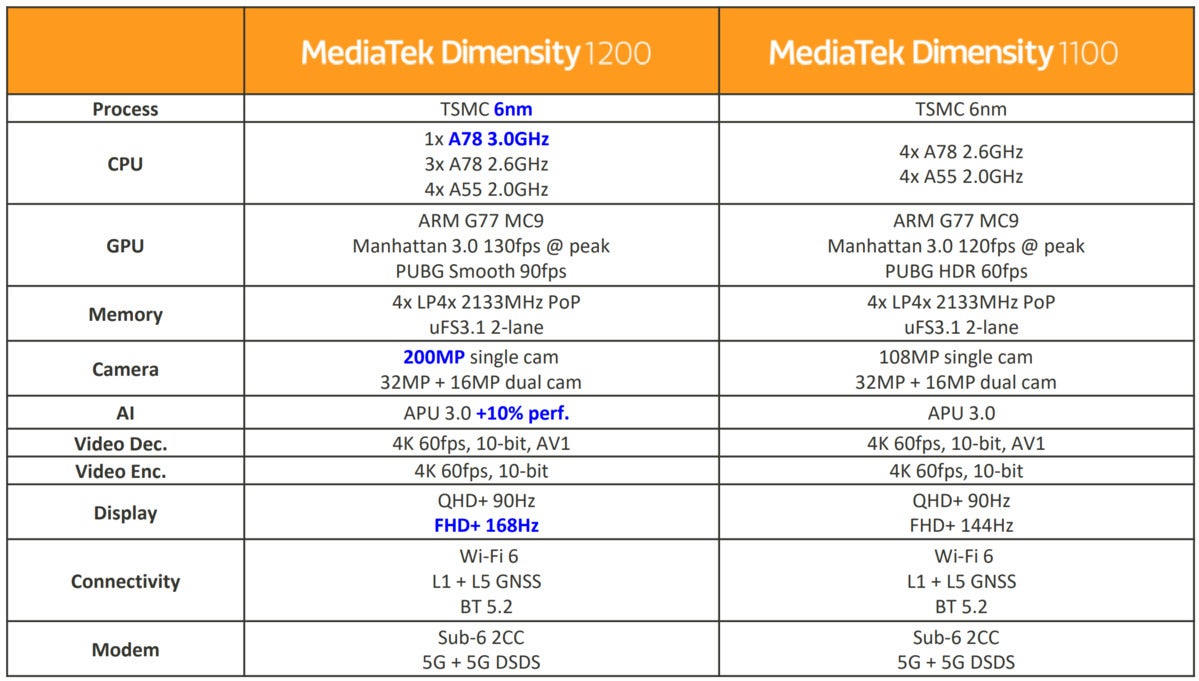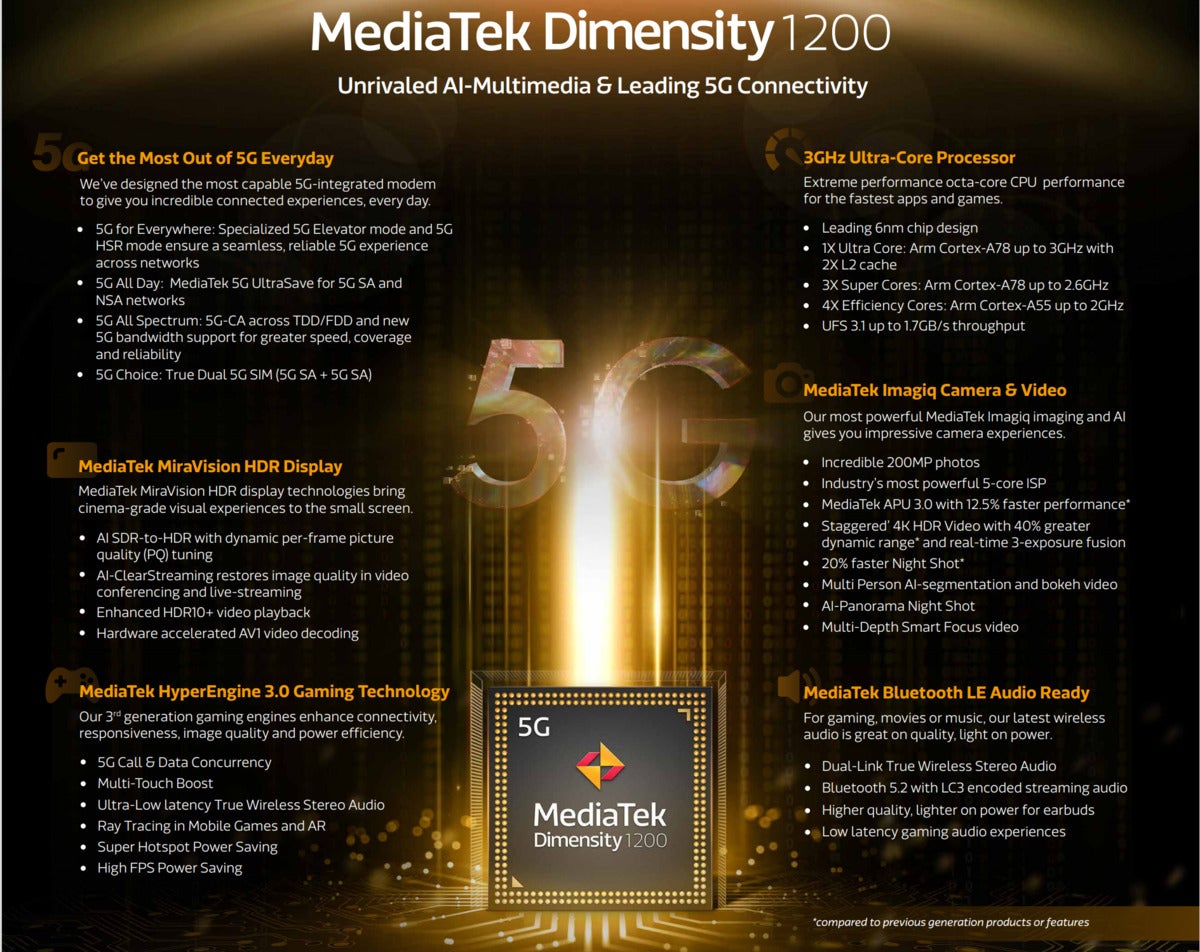On Tuesday night, MediaTek launched the Dimensity 1100 and 1200, a pair of smartphone chipsets that aim to challenge the best that Qualcomm’s Snapdragon smartphone chipsets have to offer.
MediaTek released just two performance benchmarks to support its claims. But the specs of both the Dimensity 1100 and 1200 CPUs match up well against the Snapdragon 888, Qualcomm’s recent smartphone launch, with even higher clock speeds. There’s a good chance that you’ll have either one or the other in your next phone.
While Qualcomm tends to dominate the market for smartphone chipsets that cover premium phones, MediaTek is actually the largest smartphone chipset vendor in the world, with 31 percent market share, according to CounterPoint Research. MediaTek passed Qualcomm during the third quarter of 2020, thanks especially to the rise of midrange phones and MediaTek’s success in India and parts of Asia. MediaTek’s presence was helped by aggressive pricing moves to help the lower the cost of 5G phones, as well as support by phone makers like Xiaomi.
Those phone makers are apparently lining up yet again for the Dimensity 1200 and 1100, as MediaTek recorded support by Xiaomi, Vivo, Oppo, and realme. The world’s cheapest 5G device, the realme V3, is already powered by MediaTek, Counterpoint noted.
“We’re going to continue to see 5G coming into all price points and we’re going to continue to work hard to make 5G available for everybody,” Finbarr Moynihan, general manager of corporate sales for MediaTek, said during a briefing with reporters. The new chipsets integrate the company’s existing M75 sub-6GHz 5G modem, he said, with support for FDD and TDD technologies and 5G “Elevator Mode” for smooth handoffs as the phone moves inside a building.
The Dimensity 1200’s CPU emphasizes speed
MediaTek’s Dimensity 1200 chipset mirrors Qualcomm’s Snapdragon designs: one “ultra” core for ultimate performance, plus three “super cores” for the bulk of the workload and four “efficiency” cores for low-power tasks. The 1100 foregoes the additional ultra core, balancing the four “super cores” with an additional four efficiency cores. Both the 1200 and 1100 chips are fabricated on a 6nm process.
 MediaTek
MediaTek
The Dimensity 1200 and 1100 are designed in a familiar “big-little” way.
What’s interesting, though, is the Dimensity 1200 runs at higher clock speeds. Qualcomm’s Snapdragon 888 uses a 2.84GHz X1 core as its ultra or “prime” core, followed by three 2.4GHz Cortex-A78 prime cores and four 1.8GHz A55 efficiency cores. The MediaTek Dimensity 1200 uses a 3GHz Cortex-A78 as the ultra core, three 2.6GHz Cortex-A78 super cores, and four 2GHz A55 chips as its efficiency cores. Both Dimensity chipsets have a nine-core Arm Mali-G77 GPU, MediaTek added.
The key difference is what Qualcomm calls its X1 core, which the company has said offers 20 percent more performance than the Cortex-A78. Is the Dimensity as powerful as the Snapdragon 888? On paper, it’s hard to tell: The 1200’s increase in clock speed offers just a 6-percent improvement over the Snapdragon 888. MediaTek also characterized the chip as capable of displaying a “smooth 90 frames per second” in the mobile version of Player Unknown’s Battlegrounds.
 MediaTek
MediaTek
A summary of the two new Dimensity chips, as supplied by MediaTek.
But there’s one direct comparison that we have between the two. MediaTek cited GFXBench’s Manhattan test, which uses the OpenGL ES 3.0 API and renders a 1080p scene offscreen, as another gaming benchmark. According to MediaTek, the chip generated 130 frames per second. Though the all-virtual Snapdragon Technology Summit Qualcomm held in December didn’t allow for hands-on benchmarking, Qualcomm’s own numbers (compiled in depth by XDA-developers.com) showed that the Snapdragon 888 recorded a score of 169, or 30 percent faster than the 1200.
According to MediaTek, the Dimensity 1100 can output 60 frames per second with HDR on PUBG, and 120 fps using the Manhattan benchmark.
“There’s always a tradeoff between how much you can really get out of pushing the performance of one peak CPU core, versus how much you can use on a more sustained basis,” Moynihan said, in explaining MediaTek’s CPU design decision. “We’re trying to balance...peak performance versus sustained performance, and we felt this was a good solution.”
Because of the emergence of gaming, especially in Asia where a number of MediaTek’s partners primarily sell, the Dimensity 1200’s gaming features include support for up to 168Hz displays, for smooth rendering. (The 1100 supports up to 144Hz displays.) MediaTek also designed in a feature that allows the phone to connect to the Internet and continue gaming while the user takes a voice call, Moynihan said.
MediaTek is also adding some raytracing capabilities, but only via a software partnership, Moynihan said, as the Mali-G77 doesn’t directly support it.
 MediaTek
MediaTekWhat the Dimensity 1200 brings to smartphone cameras
Qualcomm has gone to great lengths to pack in features inside of its Image Sensor Processor, or ISP. MediaTek didn’t provide that level of detail during its own explanation of the new Dimensity features, but there are still some interesting additions.
Both chips include what MediaTek calls its five-core APU 3.0, capable of capturing up to 200MP images on the 1200 and 108MP images on the 1100. The Dimensity also taps its built-in AI capabilities for various effects, such as its new multi-person bokeh, another name for the “portrait mode” that can keep the subjects of the photo in focus and blur the remaining background. AI is also used to improve high-dynamic range (HDR) capabilities by 29 percent, Moynihan said. The camera ISP is capable of 10-bit HDR resolution. Finally, AI is also being used for scene detection and enhancement in night shots, Moynihan said.
From a video perspective, the new Dimensity ISP can capture 4K video in HDR, but it can also play back standard 4K video, captured without using HDR, in an AI-enhanced HDR mode. (Microsoft’s new Xbox Series X does something similar, by using the processor to add HDR to games that don’t natively support it.)
From an audio perspective, both the Dimensity 1200 and 1100 both support Bluetooth 5.2, which lets users stream to multiple wireless devices simultaneously, the company said. The chipsets also support ultra-low latency true wireless stereo audio and LC3 encoding.
Will you see MediaTek’s new Dimensity in your next smartphone? It's hard to say. But the more MediaTek continues to take aim at the flagship smartphone market, the more likely it may be.
"Smartphone" - Google News
January 20, 2021 at 02:20PM
https://ift.tt/3bWMn1c
MediaTek's powerful Dimensity 1200 smartphone CPU will challenge Qualcomm - PCWorld
"Smartphone" - Google News
https://ift.tt/2QXWyGT
https://ift.tt/2KSW0PQ
Bagikan Berita Ini














0 Response to "MediaTek's powerful Dimensity 1200 smartphone CPU will challenge Qualcomm - PCWorld"
Post a Comment